In capsule
This is about how an ecologically disastrous barge canal project became a 110-mile linear park across the state of Florida that benefits wildlife and people.
People and animals would benefit from more projects like this one, where we recognize that modern infrastructure and wildlife need to coexist.
This greenway would not exist without the determined efforts of Marjorie Harris Carr and the Florida Defenders of Wildlife – victories do happen. (With an aside about how gender discrimination may have helped steer Carr into becoming an activist.)
As interstate traffic whizzes below, cyclists and bears pass safely above
Above the thundering roar of traffic on Interstate 75 in north central Florida, a human-made “land bridge” provides safe passage for wildlife and people. About ten miles south of downtown Ocala, travelers on I-75 can look up to see this strange overpass sprouting trees and shrubs. There are no connecting exits or entrance ramps because this passage on the Marjorie Harris Carr Cross Florida Greenway is all about avoiding vehicles.
I finally had a chance to cross it from above recently. A friend and I hiked in from the Land Bridge Trailhead to the east. We walked on the sandy trail through a forest of oaks and pines in the woodsy quiet under intensely blue skies. There were live oaks and scrub oaks and longleaf pines. The quiet was punctuated with calls from Carolina wrens, a pileated woodpecker, and a red-shouldered hawk. A shredded longleaf pinecone offered evidence of a Sherman fox squirrel having had a very recent meal from its tasty, nutty seeds, which are encased in a cone so densely closed that few critters besides these mighty squirrels are able to crack them open when the nuts are fresh.
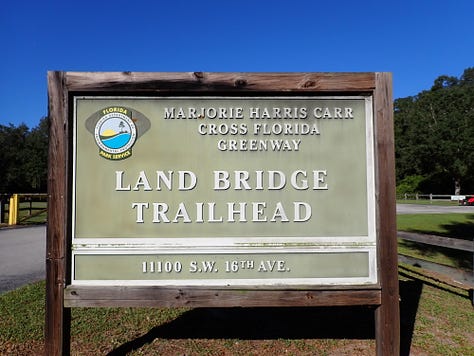
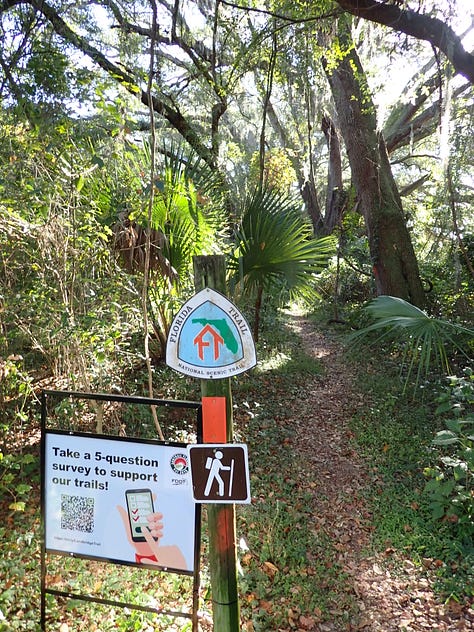
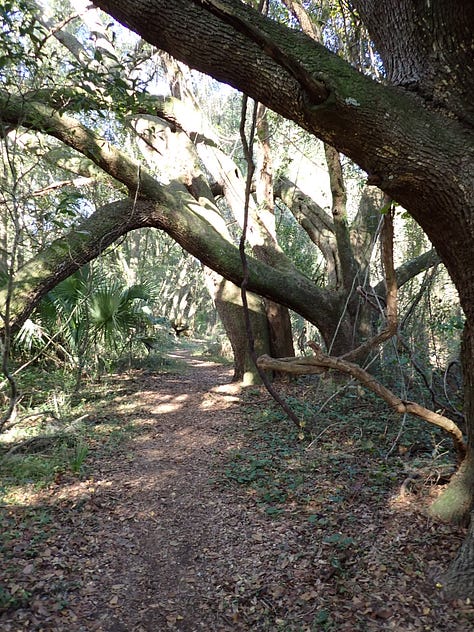
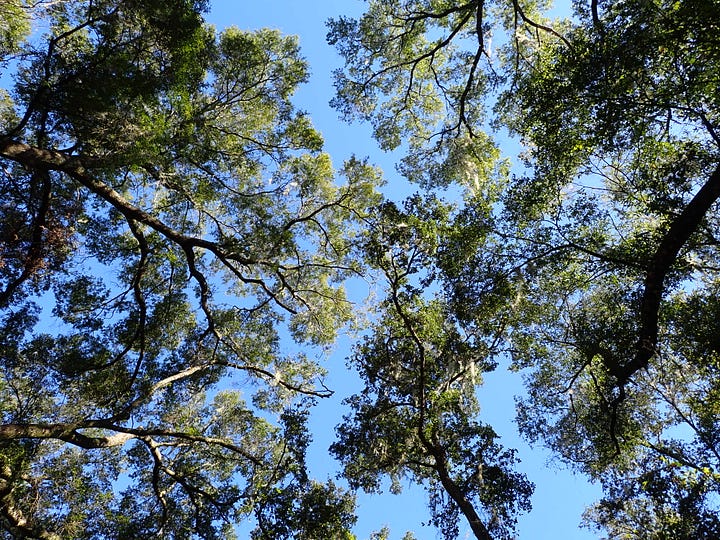
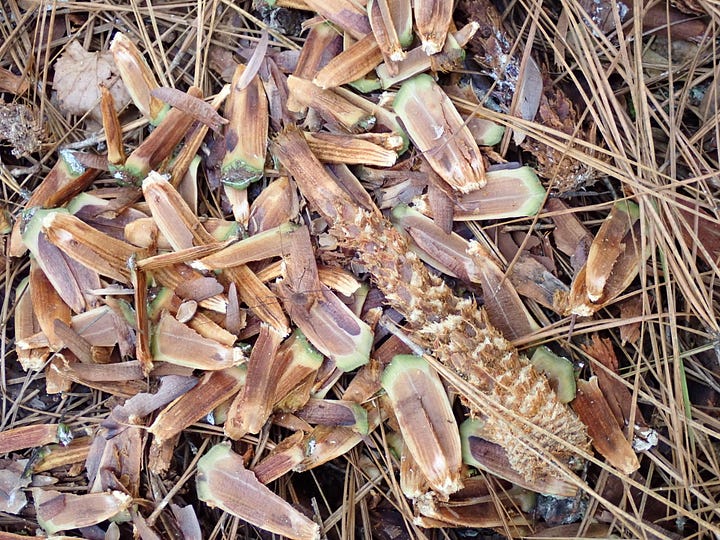
We felt surrounded by thriving natural habitat. It was the kind of setting where you can exhale and feel peaceful. After hiking about a mile, the dull roar of the interstate became audible, sounding a bit like a distant waterfall.
The wilds and modernity met in a flash when we reached the overpass. Local limerock half walls and concrete panels emerged to hem in a paved lane that formed a funnel of safety above the thundering cavalcade below. The sides of the overpass were buttressed with native trees and shrubs, giving way to wrought iron fencing in the middle, from which we could see the traffic below. In the short time we were there, dozens of cyclists passed by from both directions. On the west side of the passage was a wildlife camera that captured images of other travelers of the four-footed, scampering, or perhaps slithering variety not generally present at the height of day. According to the Florida State Parks website about the greenway, the camera has captured bobcat, coyote, wild turkey, and plenty of Florida black bears in transit.
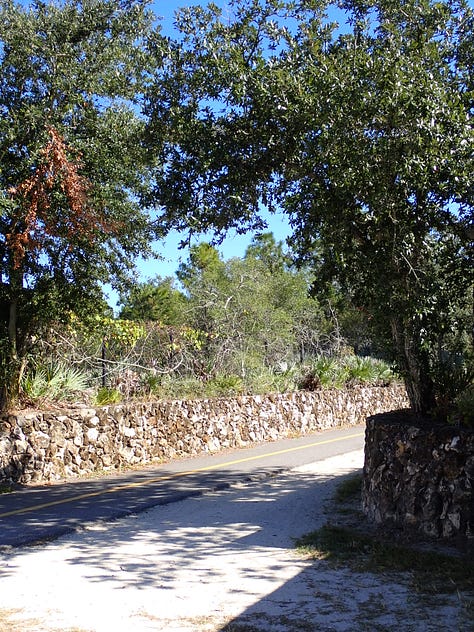


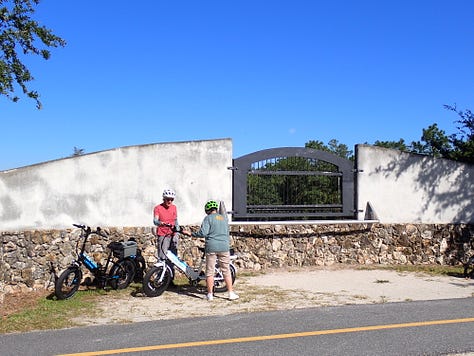
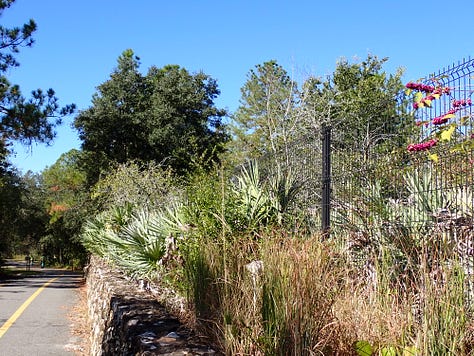
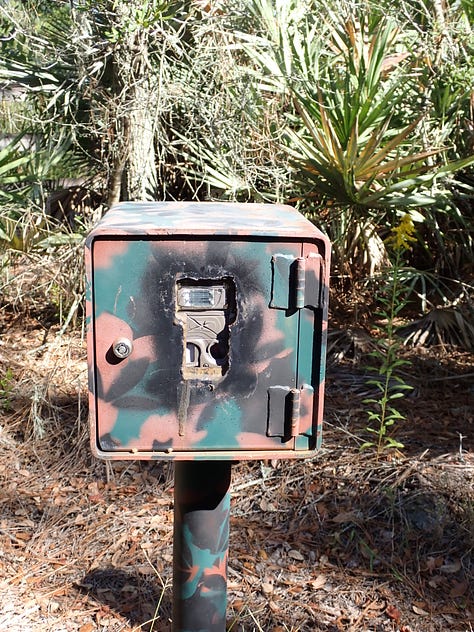
A state-spanning greenway
The overpass is a vital link about midway in a greenway that stretches 110 miles from the Gulf Coast to the St. Johns River. It encompasses 70,000 acres of land and spans a mile at its widest. Using the corridor, bears and other creatures can expand their ranges to obtain food, mate, and generally do what they do, helping them keep healthy and avoiding genetic isolation.
Not only is the greenway vital for wildlife, it also has helped to generate a thriving eco-tourism economy that draws adventurers to its 300 miles of trails for hiking, biking, birdwatching, horseback riding, and boating. The greenway merges with the Florida National Scenic Trail (better known as just the Florida Trail), one of 11 such long-distance trails in the nation. It also links to the nationally recognized Santos mountain bike trails.
From barge canal to greenway
The greenway “land bridge” overpass was completed in 2000, although it didn’t receive its current name honoring Marjorie Harris Carr until eight years later. It was the first overpass in the state of Florida built over a major highway to benefit wildlife.
The building of the land bridge overpass was a capstone to one of Florida’s biggest conservation victories – halting the Cross Florida Barge Canal. Construction of an end-to-end canal would have cut clean across the state to enable a shipping short-cut that would allow ships to avoid the journey around Florida’s long peninsula and across the Florida Straits. Think of it as a scaled back version of the Panama Canal. Constructing it would have disrupted the hydrology and ecology of ecosystems founded on Florida’s geology of porous limestone. These are rife with artesian springs. Salt water would have mixed with fresh and wildlife connections would have been fragmented north to south by the moat-like canal. Thankfully, nearby freshwater artesian springs and river runs today still are enchantingly clear and bountiful. These would have been greatly affected by this blunt geologic incision; and the entire twisty, turning gator-filled Ocklawaha River that still evokes Florida’s distant more pristine past would have been irretrievably damaged (instead of part of the Ocklawaha, which conservationists have long sought to restore).
The construction didn’t happen. Or, more factually, only one-third of it did, with the most extreme damage averted.
Today’s greenway follows the path of the partially built canal, which was conceived as far back as colonial times and intermittently worked on until activists from the Florida Defenders of Wildlife, led by Marjorie Harris Carr, convinced President Richard Nixon to sign an executive ordering halting the project in 1971. The one-third of the project that was completed is evident in remaining channelized waterways with locks, dams, reservoirs and embankments.
Congress finally deauthorized the project in 1990, forever ending the possibility of yet another revival in its off-and-on construction odyssey. Florida’s U.S. Senators Bob Graham and Connie Mack led the deauthorization, which called for a canal to be replaced by a greenway corridor at least 300-yeards wide to be created and maintained along the former canal route. The land was turned over to the state the next year with a change in purpose to recreation and conservation. In 1998, the year after Carr died, the greenway was named in her honor. Two years later, the Florida Department of Transportation completed the bridge, at a cost of $3.1 million paid from federal gas tax revenues designated for non-motorized transportation.
It does happen! This greenway was made possible by that mythical “small group of thoughtful, committed citizens….”
The familiar quotation from Margaret Mead, “Never doubt that a small group of thoughtful, committed citizens can change the world; indeed, it’s the only thing that ever has,” corny and overused as it is, does ring true for how the canal was stopped and a greenway created in its place.
The committed citizens were led by the Florida Defenders of the Environment, co-founded in 1969 by Marjorie Carr and David Anthony, both Audubon Society members. Legal support came from the Environmental Defense Fund, relying on Carr’s and others scientific expertise to detail the environmental harm that the canal would wreak. Over a campaign of more than two decades, they persisted. Finally, they put an end to a project that had been imagined by Spanish colonists, begun during the Franklin D. Roosevelt administration as a public works project, continued during World War II as a national defense project, and rebooted by President John F. Kennedy and his successor, Lyndon Johnson.
Reflecting on the life and career of Marjorie Harris Carr, I wonder if the Florida Defenders of the Environment would even have existed if talented female scientists including Carr had not been discriminated against and marginalized. Carr’s turn to advocacy came after, as a Phi Beta Kappa zoology graduate of Florida State University, she faced many challenges in furthering her education and career in biology. Carr’s biography by Peggy MacDonald chronicles her determination, the barriers she faced, and how she fused her scientific knowledge and training to pour her energy and talents into being a powerful advocate for Florida’s environment.
Florida is the better for her turn to advocacy.
As reported by the Tampa Bay Times, at a ceremony to induct her into the body of “Great Floridians,” former governor Lawton Chiles said, “Her efforts to deauthorize the Cross Florida Barge Canal began with one person and ended years later with thousands of citizens convincing their elected representatives of the detrimental nature of this project.”
Marjorie Harris Carr in her later years. Florida Memory Project.
Building Bridges
The greenway belongs to the best of Florida – its park system and conservation areas, managed under various entities. These places give a foothold to Florida’s besieged wildlife and offer people a chance to become acquainted with the state’s rich natural heritage. Amidst the ecosystem carnage that prevails in the state, places like this kindle hope for a future where rapacious development gives way to having habitat for people and wild things.
This land bridge shows how we humans can take responsibility for our dominant role in shaping ecosystems. We need roads, railroads, and waterways for travel and commerce. But we can build them responsibly and only when truly needed, and we can devise corresponding safe passages for free-roaming wildlife and people to ameliorate their impacts. We are past the time when we can think of the boundaries within parks or refuges as sufficient to meet the needs of wildlife. Those lines between nature and us are false. We live together. We need to get outside more in safe spaces. We benefit from hearing the hawks and seeing the bear’s footprints (even if we may not want to actually see the bear).
So, next time you’re on I-75 going under this curious forested overpass, grab a moment of inspiration from knowing that you’re looking up at just one small piece of what is a statewide ribbon of Florida wilds. Better yet, think about how it exists in place of the industrialized canal you could be seeing on a very different overpass. Take heart. Take action.
If you want to hike across the overpass, start at 8282 S.E. Highway 314, Ocala FL 34470.
Next time:
The state of Florida has a strong commitment to developing greenways – spanning political affiliations, yet Florida could do more to support its outstanding state park system.





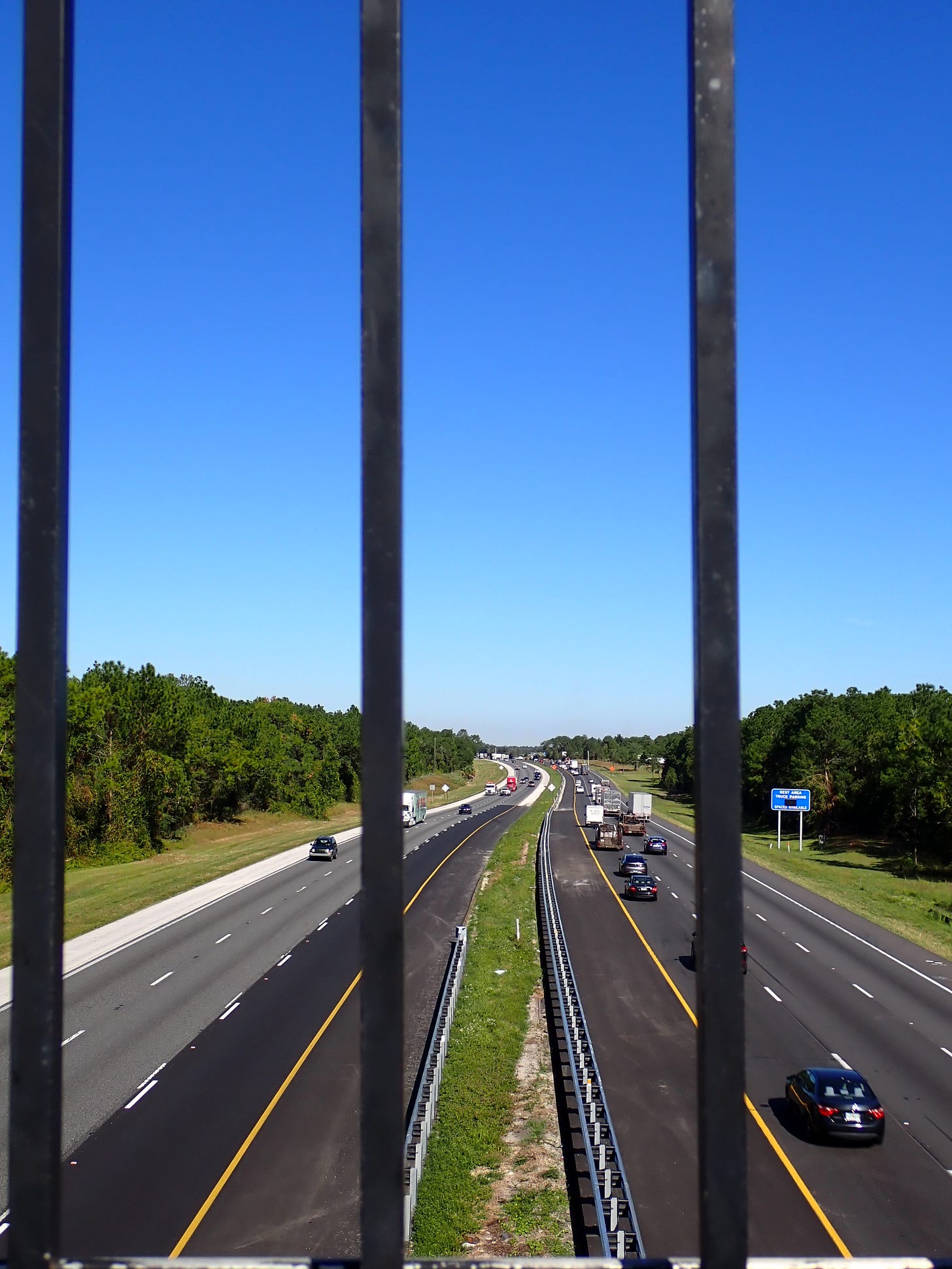
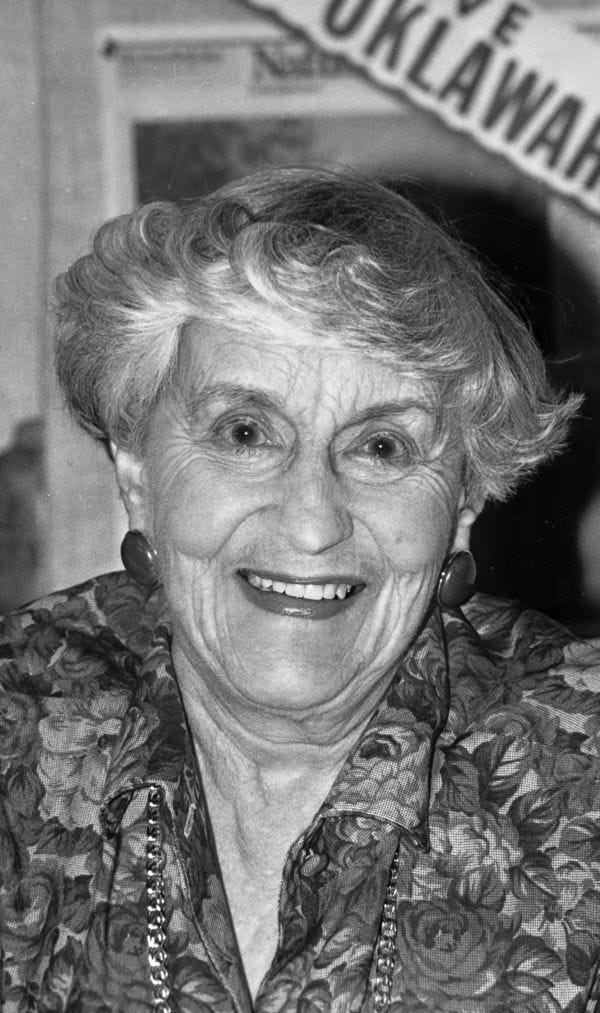
Thank you for this inspiring story!